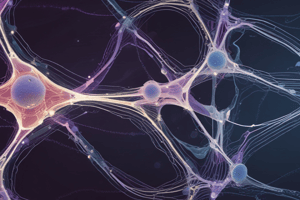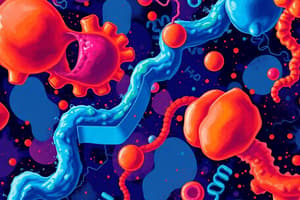Podcast
Questions and Answers
What is the range of carbon atoms in monosaccharides?
What is the range of carbon atoms in monosaccharides?
- 3 to 5
- 3 to 6 (correct)
- 5 to 8
- 4 to 7
What is the general formula of monosaccharides?
What is the general formula of monosaccharides?
- CnH2nOn-1
- CnH2n-1On
- CnHnOn
- CnH2nOn (correct)
What is unique about the arrangement of carbon atoms in monosaccharides?
What is unique about the arrangement of carbon atoms in monosaccharides?
- Branched arrangement
- Unbranched arrangement (correct)
- Variable arrangement
- Ring-shaped arrangement
How many different monosaccharide types occur naturally?
How many different monosaccharide types occur naturally?
What is characteristic of polymers of monosaccharides?
What is characteristic of polymers of monosaccharides?
What is the monosaccharide type that makes up glycogen and starch?
What is the monosaccharide type that makes up glycogen and starch?
What is the monosaccharide type that makes up cellulose?
What is the monosaccharide type that makes up cellulose?
What is a characteristic of monosaccharides in forming polymers?
What is a characteristic of monosaccharides in forming polymers?
What is the characteristic feature of monosaccharides?
What is the characteristic feature of monosaccharides?
What is the main difference between aldoses and ketoses?
What is the main difference between aldoses and ketoses?
What is the simplest type of monosaccharide, based on the number of carbon atoms?
What is the simplest type of monosaccharide, based on the number of carbon atoms?
What is the result of an intramolecular reaction between the hydroxyl group and the carbon of the aldehyde or ketone group?
What is the result of an intramolecular reaction between the hydroxyl group and the carbon of the aldehyde or ketone group?
Why are cyclic monosaccharides more stable than linear ones?
Why are cyclic monosaccharides more stable than linear ones?
What is the name of the cyclic monosaccharides with six-member rings?
What is the name of the cyclic monosaccharides with six-member rings?
What is the name of the cyclic monosaccharides with five-member rings?
What is the name of the cyclic monosaccharides with five-member rings?
How can monosaccharides be classified based on their cyclic structure?
How can monosaccharides be classified based on their cyclic structure?
What is the binding site for amino acids in tRNA?
What is the binding site for amino acids in tRNA?
What is the function of aminoacyl-tRNA synthetases?
What is the function of aminoacyl-tRNA synthetases?
What is the characteristic of the secondary structure of tRNA?
What is the characteristic of the secondary structure of tRNA?
What is the role of snRNA in the cell?
What is the role of snRNA in the cell?
What is the length of snRNA?
What is the length of snRNA?
What is the name of the complex formed by snRNA and specific proteins?
What is the name of the complex formed by snRNA and specific proteins?
What is the primary role of helicases and gyrases or topoisomerases in transcription?
What is the primary role of helicases and gyrases or topoisomerases in transcription?
What is the main difference between transcription and replication in terms of template usage?
What is the main difference between transcription and replication in terms of template usage?
What is the typical sequence of events during transcription?
What is the typical sequence of events during transcription?
What is the primary function of RNA polymerase during transcription?
What is the primary function of RNA polymerase during transcription?
What is the purpose of the specific sequences that represent gene start and end?
What is the purpose of the specific sequences that represent gene start and end?
What is the primary difference between mRNAs and rRNAs?
What is the primary difference between mRNAs and rRNAs?
How many RNA types are described in the provided content?
How many RNA types are described in the provided content?
What is the total number of genes in human cells, according to the content?
What is the total number of genes in human cells, according to the content?
What is the primary mechanism by which DNA exerts its activity?
What is the primary mechanism by which DNA exerts its activity?
What is the role of proteins in determining the molecular identity of cells?
What is the role of proteins in determining the molecular identity of cells?
What is the primary function of proteins in gene expression?
What is the primary function of proteins in gene expression?
What is the role of proteins in the morphology of organisms?
What is the role of proteins in the morphology of organisms?
What is the result of proteins interacting with one another and with diverse molecules?
What is the result of proteins interacting with one another and with diverse molecules?
What is the role of proteins in the storage and transportation of particles?
What is the role of proteins in the storage and transportation of particles?
What is the relationship between proteins and the life of cells and organisms?
What is the relationship between proteins and the life of cells and organisms?
What is the role of proteins in the physiological processes of gene expression?
What is the role of proteins in the physiological processes of gene expression?
Flashcards are hidden until you start studying
Study Notes
Proteins and their Functions
- Proteins are responsible for almost all functions that sustain life of cells and organisms
- They determine cell structure, shape, and perform nearly all physiological functions
- Proteins determine the molecular identity of cells and are responsible for morphology of organisms (e.g. skin and hair colors, size, and shape)
- They are involved in crucial physiological processes such as gene expression, DNA replication, and transportation of particles
- Proteins achieve their functions by interacting with one another and with diverse molecules from other classes (organic and inorganic)
Carbohydrates
- Carbohydrates are classified based on the number of carbon atoms per molecule, type of functional group, cyclic shape, and number of monomers
- Monosaccharides (simple carbohydrates) have the general formula CnH2nOn, where "n" ranges between 3 and 6
- Aldoses have an aldehyde group, while ketoses have a ketone group
- Glyceraldehyde and dihydroxyacetone are the simplest monosaccharides, named trioses since each comprises 3 carbon atoms
- Monosaccharides can occur in open-chain or cyclic (ringed) molecules, with the cyclic form being more stable
Transcription and Translation
- Transcription of genes into RNA is carried out by specific enzymes named RNA polymerases, helped by helicases and gyrases or topoisomerases
- Transcription principle is similar to that of replication, using DNA as a template to determine the sequence of the newly synthesized RNA molecule
- Unlike DNA replication, transcription is concerned with specific DNA stretches, named genes
- Transcription occurs in three steps: initiation, elongation, and termination
RNA Types
- RNA is divided into several classes: rRNA (ribosomal), mRNA (messenger), tRNA (transfer), snRNA (small nuclear), and others
- Each tRNA is characterized by an anticodon and is specifically charged with the corresponding amino acid
- All tRNA types have the same general trefoil structure with three loops, packed into an L-shaped tertiary structure
- snRNA length is between 50-200 nucleotides and are always associated with specific proteins forming nucleoprotein complexes (snRNP)
Studying That Suits You
Use AI to generate personalized quizzes and flashcards to suit your learning preferences.




